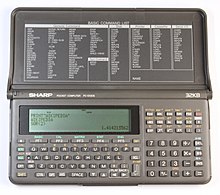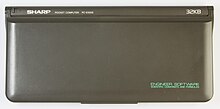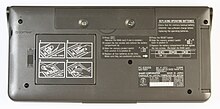Sharp PC-E500S
 Sharp PC-E500S in RUN mode (BASIC programming) | |
| Type | Pocket computer |
|---|---|
| Introduced | 1995 |
| Discontinued | 2003 (last known production run so far: 2001) |
| Predecessor | Sharp PC-E500 |
| Calculator | |
| Entry mode | Infix, BASIC, |
| Precision | 10 (single precision) 20 (double precision; not available in CAL, MATRIX, and STAT modes) |
| Display type | LCD dot-matrix |
| Display size | 4×40 characters |
| CPU | |
| Processor | Sharp SC62015 |
| Frequency | 2.304 MHz |
| Programming | |
| Programming language(s) | BASIC |
| User memory | 32 KB (built-in), custom-expandable to 256 KB |
| Firmware memory | 256 KB |
| Interfaces | |
| Ports | 1 vendor-specific (serial/printer/disk drive) 1 TTL-level serial communications port |
| Other | |
| Power supply | 4× AAA 1× CR2016 |
| Power consumption | 0.09 W |
| Weight | 340 g (including lid and batteries) |
| Dimensions | 22×10.45×1.9 cm (lid closed) |




The Sharp PC-E500S was a 1995 pocket computer by Sharp Corporation and was the successor to the 1989 PC-E500 model, featuring a 2.304 MHz CMOS CPU.
Description
[edit]It was slightly wider, and the keys are slightly larger than the previous model. The display had more contrast, and the keyboard cover is a (removable) hinged lid (clamshell) instead of plastic slipcase. There were also four additional BASIC commands (Multiline IF ... ENDIF, WHILE ... WEND, REPEAT ... UNTIL, SWITCH ... CASE ... ENDSWITCH)[1]
It came with 32 KB of RAM which could be upgraded to 96 KB using memory expansion cards. The monochrome LCD had 240×32 pixels which could display four lines with 40 characters per line as well as graphics. The 256 KB system ROM that contained the BIOS, a diagnostic suite,[2] and the BASIC interpreter used to program the device.
An algebraic calculation system was included. The Algebraic Expression Reserve (AER) memory: Frequently used formulas or constants could be stored in memory and recalled for repeated use. The PC-E500 series also performed as a scientific calculator when switched into 'CAL' mode.
It also included an X<>Y exchange key for working with complex numbers and polar to rectangular conversions.
Applications
[edit]- Mathematics (integers, equations, differential & integral calculus, formulas and graphs)
- Physics
- Earth sciences
- Meteorology
- Chemistry
- Biology
- Geology
- Electrical engineering
- Mechanical engineering
In addition things like amino acids and the periodic table of elements were available. These built-in programs were accessed through a menu system and special function keys. There was also a built-in menu editor to add new software to the menus or indeed replace some built-in software or formulas.
Operating modes
[edit]- BASIC (programming and execution)
- CAL (scientific calculator)
- MATRIX (matrices calculations)
- STAT (statistics)
- ENG (engineering)
- AER (algebraic expressions editor). This mode can be accessed from the second main menu page (press up/down arrow near the lower left display corner).
Accuracy
[edit]- 10 digits (mantissa) + 2 digits (exponent) in single-precision mode.
- 20 digits (mantissa) + 2 digits (exponent) in double-precision mode.
- In the CAL, MATRIX and STAT modes, only the single precision mode can be used.
Memory expansion
[edit]The Sharp PC-E500 series could store data and programs on memory expansion cards as well as the main RAM. Six cards were available:
- CE-210M: 2 KB
- CE-211M: 4 KB
- CE-212M: 8 KB
- CE-2H16M: 16 KB
- CE-2H32M: 32 KB
- CE-2H64M: 64 KB
These cards used a CR1616 lithium battery for memory backup.
The memory configuration was software-switchable from the command-line. The RAM card could be appended to the system memory, replace the system memory or act as a separate space to be used as a RAM drive (F:). The main memory could also be partitioned off to a RAM drive (E:).
Peripherals
[edit]- CE-126P: Thermal printer & cassette interface.
- CE-140F: 2.5-inch pocket floppy drive.
- CE-130T: RS-232 adaptor level converter.
- CE-135T: RS-232 adaptor level converter. (Macintosh)
- CE-515: 4-color X/Y plotter printer
The PC-E500S had a weight of 340 g (with batteries) and was powered by four AAA batteries. It could, given its power consumption of 0.09 W, be used for about 70 hours on a charge.[3]
Variants
[edit]- PC-E500 (English): 32 KB, engineer software, double precision, slipcase, rubber keys, black, 1988/1989
- PC-E500 (Japanese): 32 KB, engineer software, double precision, Kanji, slipcase, rubber keys, black, 1988[4]
- PC-E500PJ / PC-E500-BL (Japanese): 32 KB, engineer software, game "HEAVY METAL mini" (by CRISIS Software) preloaded into RAM, double precision, Kanji, slipcase, rubber keys, blue, 1990, limited special edition by Pokecom Journal (PJ)[5]
- PC-E500S (English): 32 KB, engineer software, double precision, high contrast display, clamshell, plastic keys, black, 1995[6]
- PC-E550 (Japanese): 64 KB, engineer software, double precision, Kanji, slipcase, rubber keys, white, 1990[7]
- PC-E650 (Japanese): 64 KB, engineer software, double precision, structured BASIC, Kanji, clamshell, plastic keys, black, 1993[8]
- PC-1480U (Japanese): 32 KB, no engineer software, "coop uni" label, double precision, Kanji, slipcase, rubber keys, black, 1988[9]
- PC-1490U (Japanese): 32 KB, no engineer software, "coop uni" label, double precision, Kanji, slipcase, rubber keys, black, 1990[10]
- PC-1490UII (Japanese): 64 KB, no engineer software, "UNIV. TOOL" label, double precision, Kanji, slipcase, rubber keys?, black, 1991[11][12]
- PC-U6000 (Japanese): 64 KB, no engineer software, "UNIV. TOOL" label, double precision, Kanji, clamshell, plastic keys, black, 1993[13][14]
See also
[edit]References
[edit]- ^ Basic Compare mvcsys.de
- ^ a b Sharp Service Manual (OOZPCE500SSME). Sharp Corp. 1993. p. 6.
- ^ PC-E500S Bedienungsanleitung (German manual). Sharp Corporation. 1995. p. 337/338.
- ^ "PC-E500(ポケコン・ポケットコンピュータ)のことなら「自分でドットコム」(DIY)". www.jibunde.com.
- ^ "PC-E500-BL(ポケコン・ポケットコンピュータ)のことなら「自分でドットコム」(DIY)". www.jibunde.com.
- ^ "PC-E500S(ポケコン・ポケットコンピュータ)のことなら「自分でドットコム」(DIY)". www.jibunde.com.
- ^ "PC-E550(ポケコン・ポケットコンピュータ)のことなら「自分でドットコム」(DIY)". www.jibunde.com.
- ^ "PC-E650(ポケコン・ポケットコンピュータ)のことなら「自分でドットコム」(DIY)". www.jibunde.com.
- ^ "PC-1480U(ポケコン・ポケットコンピュータ)のことなら「自分でドットコム」(DIY)". www.jibunde.com.
- ^ "PC-1490U(ポケコン・ポケットコンピュータ)のことなら「自分でドットコム」(DIY)". www.jibunde.com.
- ^ "PC-1490UII(ポケコン・ポケットコンピュータ)のことなら「自分でドットコム」(DIY)". www.jibunde.com.
- ^ 電言板5 PC-1490UII PROGRAM LIBRARY (in Japanese). Vol. 5. University Co-op. 1991. (NB. University Co-operative)
- ^ "PC-U6000(ポケコン・ポケットコンピュータ)のことなら「自分でドットコム」(DIY)". www.jibunde.com.
- ^ 電言板6 PC-U6000 PROGRAM LIBRARY (in Japanese). Vol. 6. University Co-op. 1993. (NB. University Co-operative)
- SHARP Pocket Computer Model PC-E500 Operation Manual. Sharp Corporation. 1989. 9G1KS(TINSE1189ECZZ).
- SHARP Taschencomputer Modell PC-E500S Bedienungsanleitung [SHARP Pocket Computer Model PC-E500S Operation Manual] (PDF) (in German). Sharp Corporation. 1995. 6J3KS(TINSG1223ECZZ). Archived (PDF) from the original on 2017-02-24. Retrieved 2017-02-24.
External links
[edit]- Sharp PC-E500 Pocket Computer from 1989 on YouTube—demo of a Japanese PC-E500
